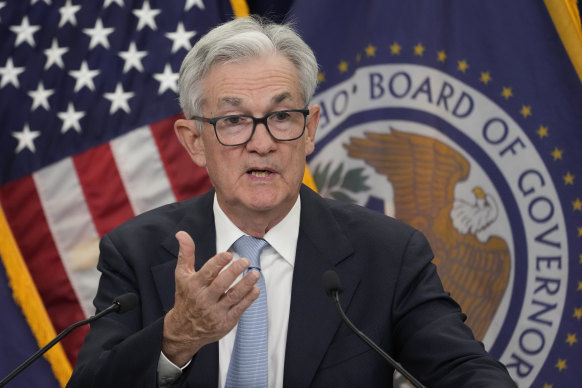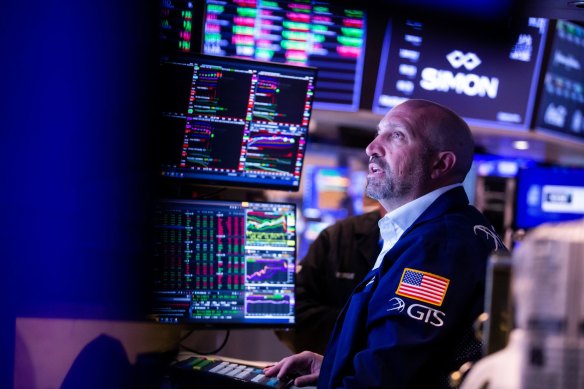This was published 2 years ago
Opinion
The Fed just made its choice. It could have serious ramifications
Stephen Bartholomeusz
Senior business columnistThe US Federal Reserve was caught within the proverbial “rock and a hard place,” forced to choose between maintaining its fight against inflation or easing the pressure on a regional banking sector in crisis. It has chosen to prioritise the year-long struggle to get inflation under control.
After the two-day meeting of its Open Market Committee, which sets monetary policy in the US, the Fed announced a 25 basis point increase in its federal funds rate, the US equivalent of the Reserve Bank’s official cash rate. It is the ninth successive increase in US rates over the past 12 months and takes them to their highest level since September 2007, on the eve of the 2008 financial crisis.

Jerome Powell says there is a long way to go in the fight against inflation. Credit: AP
The meeting was occurring against the backdrop of two regional bank failures and runs on other small and medium-sized banks as depositors fled for the safety of the mega Wall Street banks and money market funds.
The crisis in the sector is sufficiently threatening to the US banking sector and financial stability that was speculation this week that the Biden administration was developing plans to guarantee all $US19.4 trillion ($29 trillion) worth of deposits in the system. At present there is a $US250,000 ceiling on the protection for depositors.
Treasury Secretary Janet Yellen, appearing before a Senate committee in Congress on Wednesday, however, ruled out a “blanket” guarantee of all deposits but said that, where a particular bank failure was deemed a systemic risk, the government was likely to invoke the systemic risk exception used in the Silicon Valley and Signature collapses.
Her comments, made just after the Fed’s rate decision was announced, triggered a sell-off of US bank stocks and caused the US sharemarket, which had been rising, to fall heavily.
The major factor in igniting the crisis was the Fed’s near-unprecedented series of rate increases.
As rates have risen, the value of existing government bonds (with lower yields) has fallen and left the smaller banks (which, unlike their bigger counterparts don’t mark the value of their bonds to market) sitting on substantial unrealised losses and highly vulnerable to a run on their deposit bases.
That was the key reason for the collapses of the Silicon Valley and Signature banks last week. To raise the cash to meet runs on their deposits they had to sell their government bonds at substantial losses, undermining their viability. There are about $US620 billion of those unrealised losses within the US banking system.
Going into this week’s meeting, the Fed was acutely aware that another rate rise would exacerbate those paper losses. It would flow through to an increase in the interest rates the banks would need to pay to attract or retain deposits and squeeze their margins and profitability.

In the near term, the outlook for US rates, inflation, growth and stability remains clouded.Credit: Bloomberg
It would also amplify what has effectively been a tightening of financial conditions in the US because of the destabilisation of the regional banks, which provide about half of all commercial lending, 60 per cent of lending for residential property, 80 per cent of commercial real estate loans and almost half of all consumer loans.
It was the Fed’s tightening of financial conditions over the past year which triggered a banking crisis that will itself tighten conditions even more.
That crisis will shrink the regional banks’ willingness and capacity to lend and probably has the effect of at least one 25 basis point increase in the federal funds rate, but more likely two or three 25 basis point increases.
The Fed’s chairman, Jerome Powell, acknowledged that impact at the press conference after the Fed’s rate decision was announced but said it was too early to know how much the banking crisis would slow the economy.
The dilemma for the Fed – in considering whether to increase rates or pause the rate rises to take stock of the impact of the turmoil in the banking sector – was that, while a pause might have been the sensible option, it would have sent a signal about the depth of its concerns about financial stability and exacerbated the distrust among the smaller banks’ depositors.
It might also have undermined the painful gains the Fed has made in its efforts to tame inflation.
The headline rate of inflation in the US has fallen from 9.1 per cent at its peak last year to 6 per cent but “core” inflation, which excludes volatile food and energy prices, remains stubbornly steady at 5.5 per cent.
Before the stresses in the banking system emerged, Powell had flagged the potential for a 50 basis point increase at this week’s meeting because of the Fed’s concerns about core inflation. Financial markets had been pricing in a peaking of the federal funds rate at 5.5 per cent or even higher later this year.
The Fed itself, or at least a majority of the members of the Open Market Committee, now see their benchmark rate ending this year at 5.1 per cent. Given that the latest 25 basis point increase takes the Fed’s target range for that rate to between 4.75 per cent and 5 per cent that implies, at most, one more rate rise this year.
In their official statement, the committee’s members said they anticipated that “some” additional policy firming “may” be appropriate to achieve a stance for monetary policy that was sufficiently restrictive to return inflation to 2 per cent over time.
Their median projection is for a headline inflation rate of 3.3 per cent in the December quarter and a core rate of 3.6 per cent, both marginally higher than they were forecasting in December last year.
The Fed is continuing with its “quantitative tightening” – allowing bonds it bought during the pandemic years to mature without reinvesting them – which effectively withdraws liquidity from the US financial system. It has been shrinking its balance sheet by $US95 billion a month.
It is doing that even as, in response to the distress in the banking system, it is expanding its balance sheet again by lending 12-month funds to banks against collateral of their government bonds and other high-quality security that it is valuing at par, rather than their lower market value. Last week it added about $US300 billion to its holdings of cash and bonds, largely as a result of that program.
It is apparent that monetary policy for the rest of this year will be heavily influenced, as this decision was, by the state of the US banking system. If the turmoil subsides the Fed will be able to focus solely on inflation. If the instability continues, it will be forced to shift its stance and prioritise financial stability to avoid a full-scale crisis.
US interest rates, the stability of its financial system and the state of its economy matter to the rest of the world.
Other central banks have to consider the impact of US rate decisions on capital flows and the value of their currencies when determining their own monetary policies.
Last week’s run on Credit Suisse, a bank of global systemic importance, which forced it into a sale to UBS on distressed sale terms, was triggered by contagion from the US system. Economic growth in the US is a key input to global economic growth.
In the near term, the outlook for US rates, inflation, growth and stability remains clouded, with the uncertainties magnified by the awkward position the Fed has found itself in – some would say has created – of trying to deal with still-unsustainable levels of inflation and a banking crisis at the same time.
There is, for the US and the rest of the world, a lot riding on the Fed’s ability to successfully muddle its way through the next few months without reigniting inflation or inducing a wave of bank collapses that spreads more contagion throughout the US and international financial systems.
The Business Briefing newsletter delivers major stories, exclusive coverage and expert opinion. Sign up to get it every weekday morning.